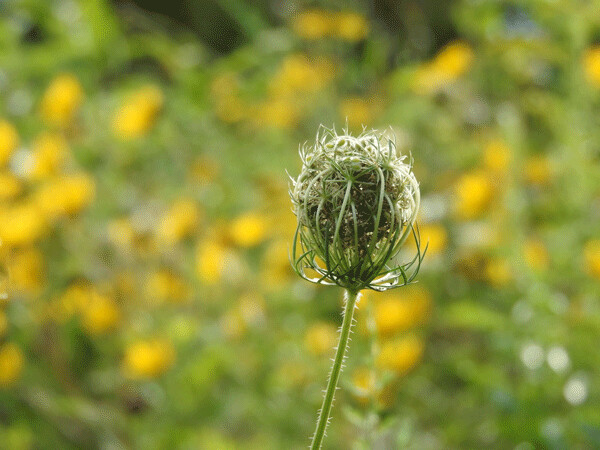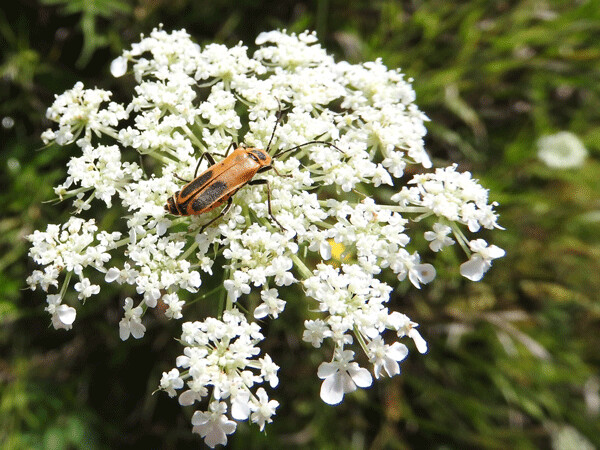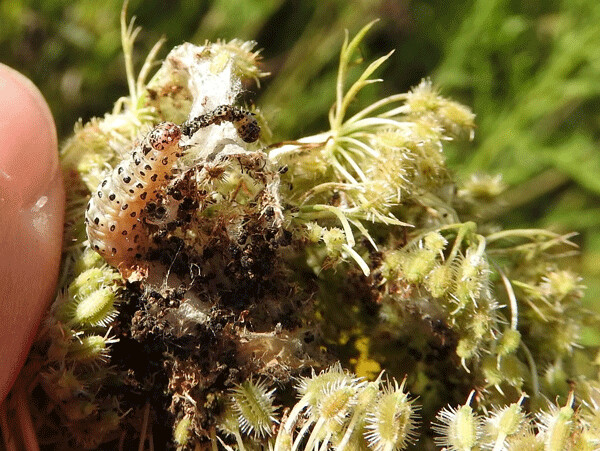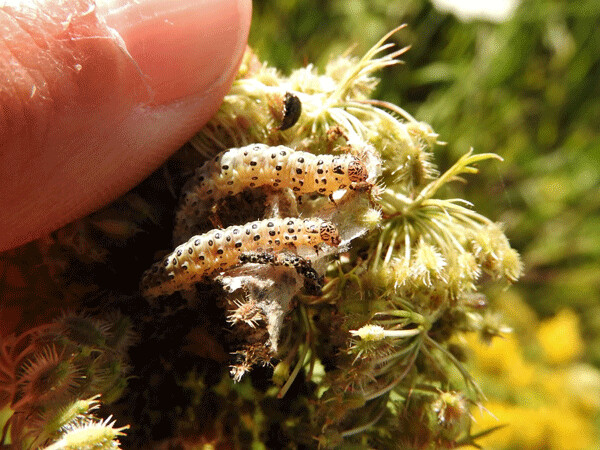Find the Stories in Nature


The bright afternoon sunshine made me blink as I headed out the back doors of Retzer Nature Center in Waukesha County, Wisconsin, near Milwaukee. A few minutes before, I’d ended the slide show portion of my “Finding the Stories in Nature” workshop, and sent the students—a delightful mix of staff and volunteers from Retzer and other nearby nature centers—out to the blooming rain gardens to “find stories.” After gathering props to use later, I headed outside, too.
The naturalists had already dispersed into small groups, and in one of those little pods, my friend, Janet Barthel, was exclaiming about something. Janet has attended several Wisconsin Master Naturalist trainings in Cable, and with her boundless enthusiasm for both nature and being organized, recently became the Nature Center Supervisor here.
Maybe it was one of the shiny black beetles scurrying around the brown goblet of a Queen Anne’s lace seed head that had sparked Janet’s curiosity. I could relate. Growing up in Iowa, Queen Anne’s lace sparked many a fanciful daydream in my curly little head. As the story goes, while Queen Anne sat tatting white lace, she pricked her finger and a drop of blood stained the center. The lace then became the frilly white flower, complete with a tiny patch of dark red petals in the center. Obviously, I’m not the first person to look for stories in nature.
Anyway, when Janet’s curiosity caused her to pry open the seed head, she found quite a surprise. Hidden inside were several little caterpillars. Light tan with black spots surrounded by yellow halos, they squirmed away from the unexpected light suddenly invading their secret hideaway. This was new and unexpected. The naturalists all got a little smile and a chuckle from the discovery, since discovering something new about nature is precisely what makes people like us tick.
Later that evening, I Googled our find. “Caterpillar in Queen Anne’s lace seed head,” quickly turned up information about carrot seed moths, Sitochroa palealis.



While these little white moths are native to eastern Russian, Portugal, Greece, North Africa, and China, they are a new arrival to North America. Probably arriving by boat, they have been reported from states along Great Lakes shipping routes since 2002. They were caught in traps intended for other pest insects, photographed and posted to bugguide.net, brought to the Ohio Lepidopterist Society’s “ID day,” and were now exposed in their feeding goblet by a naturalist looking for stories.
While all of the caterpillars we saw were feeding on Queen Anne’s lace (also known as wild carrot), they may also attack the seeds of other members of the Apiaceae family, like carrots, caraway, celery, coriander, cumin, and dill. In agricultural settings they are easily controlled with pesticides, though, so the scholarly articles describing their arrival were not overly alarmed.
As non-native invasive species, the story of these caterpillars is not anything new. Queen Anne’s lace itself is not native to this continent. It’s been here a bit longer, though, having been introduced in the soil used as ballast in ships by the first European settlers.
Old change. New change. While humans are changing the distribution of carrot seed moths in the New World, climate is changing their distribution in the old world. Migratory moths and butterflies are being monitored at a site in the southern United Kingdom, and researchers estimate that for every 1°C increase in temperatures in SW Europe, there is an increase of 14 species of Lepidopterans (butterflies and moths). The carrot seed moth is on their list of newcomers, having made the open water crossing toward cooler temperatures in about half of the study years since 1982.
While scientists worry about the impacts of newcomers, there may be some benefits, too. As the original native species decline due to habitat change, these invaders just might fill some vacant niches. That’s happened in the Namekagon River, as non-native brown trout take over the niche from native brook trout when the water warms. Likewise, the carrot seed moth may have surprising benefits. Queen Anne’s lace can be a weed as we try to restore native prairies, and the juice from its leaves may cause blisters when combined with bare skin and sunshine. In Milwaukee’s Lakeshore State Park, an entomologist observed the carrot seed moth larvae helping to keep Queen Anne’s lace under control.
Stories like these about the arrival of new invasive species and the shifts in ranges due to a warming climate aren’t going to go away. But then, neither will the stories about people hungry for a connection to nature, the benefits of boundless curiosity, and the joy of discovering something new. I’d say that the workshop was a success, wouldn’t you?
Emily’s second book, Natural Connections: Dreaming of an Elfin Skimmer, is now available to purchase at www.cablemuseum.org/booksand at your local independent bookstore, too. For more than 50 years, the Cable Natural History Museum has served to connect you to the Northwoods.
Come visit us in Cable, WI! Our new Curiosity Center kids’ exhibit and Pollinator Power annual exhibit are now open! Call us at 715-798-3890 or email emily@cablemuseum.org.
